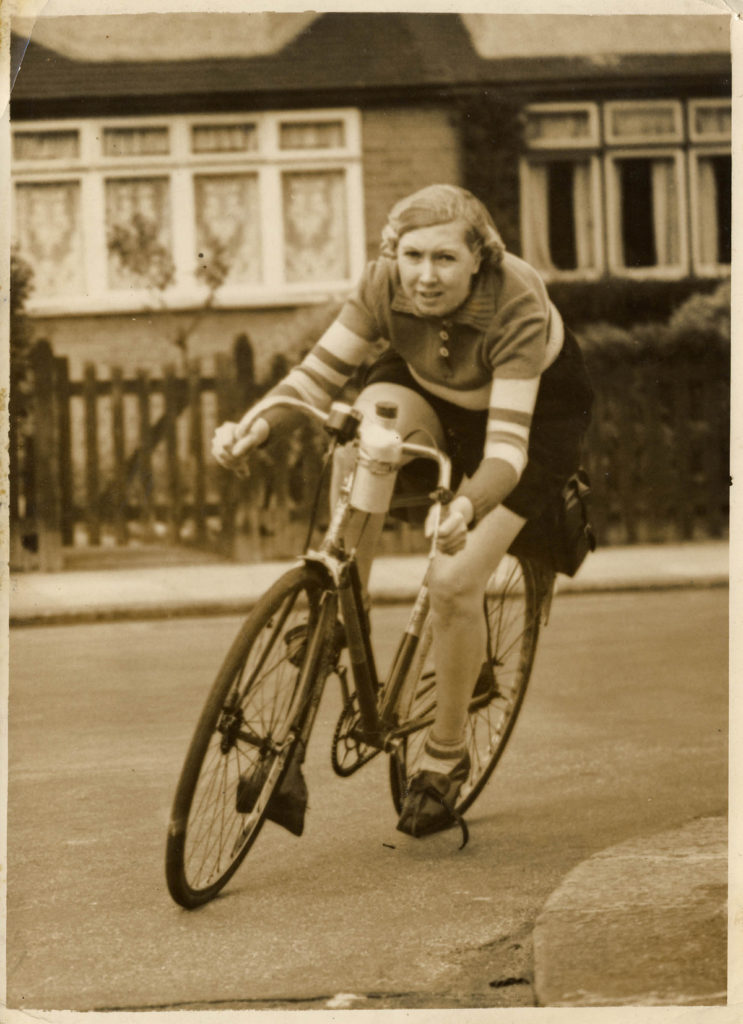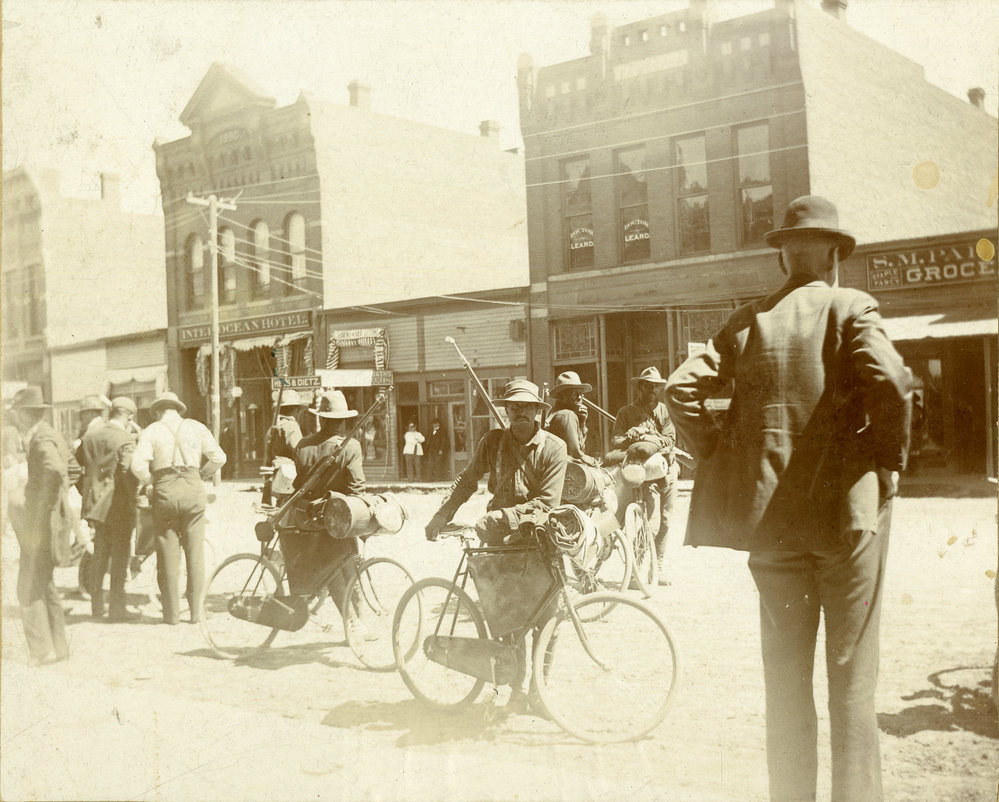By Joe Kurmaskie — In the same vein as cycling legend Major Taylor, Evelyn Hamilton, British racing phenom, equality pioneer turned war heroine, was overlooked then nearly lost to history.
It wasn’t until, as a journalist working on another unrelated bicycling article, I stumbled upon her photo and a global literary treasure hunt was set in motion.
It would take 4 years and a brush with my own mortality before I unearthed the complete story of Evelyn Hamilton… and continue to pace her legacy across the finish line of history.

When, with 50 wins in six countries, the half mile sprint record and the sporting life award under her belt, Evelyn Hamilton was barred from men’s racing and the Tour de France, she attempted and completed world record setting rides, fought sexism, Nazis, and risks it all in occupied France. She lived under an assumed name and went about rescuing airmen by bike and couriering coded messages hidden in her handlebars, (she was the inspiration for Gino Bartoli’s handlebar message exploits in Italy years later) messages that might well have determined the fate of the world.
Not content to pedal with other women in long dresses and feathered hats, she becomes a sponsored racer and lover to Europe’s largest bike manufacturer, a Great Gatsby style promoter, Claud Butler. Together they conspire to make Evelyn the most decorated cyclist in the world.
She shatters the distance record of 1,000 miles in 10 days by completing it in 82 hours of in the saddle riding. The Queen of England fires the starting gun. She gets her own line of bicycles, The Miss Modern Model of 1934. She stars in Hollywood features as Gracie Field’s cycling stunt double and becomes a darling of Pathe Newsreels. She receives the unlikely support and friendship of 1925 Tour winner, Henri Pellisier, a womanizer and chauvinist who, nonetheless, sees Evelyn’s talent for what it is. Henri warns the race world, “It’s a good thing you won’t let Evelyn compete in your Tour. She’s lightning in a saddle, and you would lose.”
She climbs from lowest to highest points in the UK, 1,000 miles in 7 days. Then turns around and covers 10,000 miles in 92 days.
But her biggest ambition, the Tour de France, remains out of reach.
England’s war footing forces her to leave the bike shop she has purchased and find races in France. When the Germans invade she’s performing in the Circle Of Death Circus outside Paris. Rather than flee, Evelyn assumes the identity of a dead Bistro owner and uses the eatery to spy on Gestapo dining there. Becoming one of the heroines of the resistance by bringing downed airman to the border on a tandem bicycle and providing so much actionable intelligence that her bike shop back in London becomes a meeting place for Charles de Gaulle and Churchill.
She was fond of saying she would have left, but that was before she learned that Hitler wasn’t a cyclist.
An excerpt from my book, (Cadence Press 2019) Lightning In A Saddle, picks up the action when she is stopped at a roadblock on a quiet rural hilltop.
Northern France, August 1944
The lane curves away from farm country, a gentle climb into the forest. Evelyn recognizes this stretch from a race she’d won in 1939. Fifty firsts across six countries by then. Not allowed to compete against men, the only challenge left was the clock and herself. That race, one of the last best times spent on a bicycle before what she’d imagined would remain a regional war burned around the globe with fury and consequence.
The countryside is full and lush; a summer dress of sunflowers and fertile soil. Everything headed for harvest. The farmers know most of it will feed an occupying army, paid for with money picked from the pockets of ghosts. These truths can’t touch Evelyn when she’s in the saddle; making little circles with the pedals and feeling the breeze on her face quiets the rage. The rest seeps out on sweat and effort. Evelyn looks like any other woman on a bicycle foraging for food during wartime. Her cover story, perfected French accent and forged papers are so flawless that for a few miles she relaxes to the rhythm of the ride, finding the inside of the road.
Long shadows stretch across the lane. It’s the warm, backend of an incendiary August afternoon. At this pace she’ll be home to work the dinner service at the bistro. Roadside wildflowers sway as she crests the hill, coming face to face with a military roadblock.
A lone German solider leans against his vehicle, machine gun slung over one shoulder, at the ready, but not drawn. He crushes out a cigarette with his boot and puts up a hand. She comes to a stop, offers a smile, the one she used as Gracie Field’s stunt double for bicycling scenes during the filming of Sing As We Go. No nerves, her papers are in order and her charms never fail.
Slips of vital intel tucked inside the handlebars of her Granby bicycle still to be passed to a resistance contact – locations and schedules of troop trains. Later in the week, under a moonless sky, it might be helping an allied airman or prisoner of war escape the country on the back of her tandem.
“Guten Tag, Gladys,” the solider says. Her surprise, slight and fleeting as it is, betrays her. Though her fate has already been sealed by someone else.
Gladys is her longstanding nickname popularized in British newsreels. Betrayal. Considering the solider’s presence on the road with such specific information, this is the only plausible explanation. A hulking specimen of Hitler’s war machine, well over 6 feet, he offers a nod and a satisfied grin.
It strikes her funny, looking back across the valley, that those were the last few curves of her life before the road has likely come unwound for good.
She stalls by asking for one of the soldier’s cigarettes. She doesn’t smoke, but if he gives one up it will indicate how little he fears her. Still grinning, he reaches into his trousers and produces the whole pack.
“Danke,” she says, coy, steady. She offers him one of his own back. He accepts it, lighting them both in a cruel mystery dance of civility. They stand in the middle of the road, smoking in silence. This can only play out a few ways, none of them good. Either he will shoot her somewhere in the forest behind them and leave her body, or take her in for questioning. There will be torture, perhaps rape, then she’ll be shot once they have what they need, or, and this is best the case scenario; questioning, torture, a train ride and slow march to death by way of concentration camp.
Or she could run.
“Does it end here, or later?” she asks.
He grins. “Do I call you Gladys or Evelyn?”
“My friends call me Gladys.”
He tips some ash. “Then Evelyn it is.”
Evelyn debates whether she wants a bit more life as a prisoner or risk dying in the next few seconds… by taking her only real shot at freedom.
She chooses to act. Timing will be everything. She wears her hair in a bun to conceal a small pistol. She’ll need to cock it in a single, fluid motion – the reach up masked as casually playing with her hair – then draw and shoot before he finishes his smoke. And hope beyond hope he isn’t able to get the nose of the machine gun up and aimed… while her aim has to be true. She’s practiced this move countless times, but it’s a very different animal in the wild.
How quickly reality can grow teeth.
Evelyn crushes out her cigarette, blows a long, smokey sigh and offers her most inviting smile. She puts everything behind it, sex and longing and a touch of sadness, men adore the myth of the sad, vulnerable woman. If she can cloud his judgement, even for a moment, get him out of his head to a place of heat and lust and…
As he raises the cigarette to his lips, she glances at her bicycle, presumably for the last time. Feeling the miles still left in her legs, Evelyn Hamilton reaches, cocks, draws and shoots…
For more, see the website for cyclist Evelyn Hamilton.








